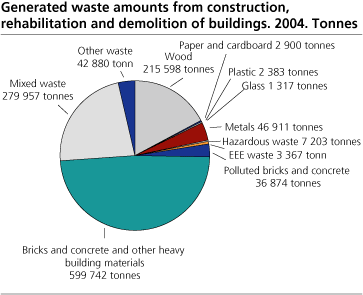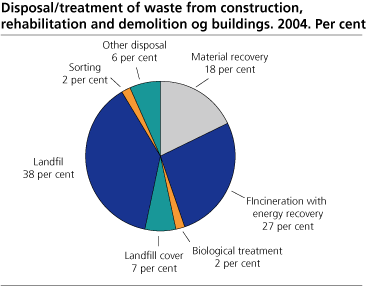Content
Published:
This is an archived release.
1.2 million tonnes of waste from building activities
Preliminary estimates show that 1.24 million tonnes of waste was generated by building activities( 1 ) in Norway in 2004. Heavy building materials, mainly bricks and concrete, constituted about half the total generated amounts.
Waste from construction, rehabilitation and demolition of buildings constitutes about 14 per cent of the total waste amounts generated annually in Norway. The vast amount of the waste contains materials that are relatively uncontaminated and which can be disposed of at landfills or reused without special environmental considerations. Some building materials do however contain hazardous substances, which must be properly treated.
Largest quantities from rehabilitation
44 per cent of the total waste amounts generated from building activities in 2004 came from rehabilitation activities. Demolition activities generated 36 per cent of the total waste amounts. Heavy building materials, mainly bricks and concrete, constituted about half the total waste amounts. This includes 37000 polluted materials.
Slightly more than 7000 tonnes of hazardous waste were generated from building activities in 2004. This is, however, a conservative estimate. Some of the waste that has been registered as polluted heavy building materials should perhaps have been included in the hazardous waste category. The amounts of plastic, paper and glass may also be underestimated in the statistics, as some of these materials are "hidden" in the mixed waste category. Mixed waste constituted 23 per cent of the total waste amounts from building activities in 2004.
60 per cent to waste plants
60 per cent of the total generated waste from building activities was delivered to public and private waste plants in 2004. The rest, mainly heavy building materials, wood and metals, was handled at the building sites or delivered directly for material recovery or to industrial plants. It is also reason to believe that some of the waste was disposed of illegally. The data and surveys used as basis for this statistics do, however, not reveal the exact disposal of the waste handled outside the waste plants.
Equal amounts recovered and landfilled
38 per cent of the total waste delivered to waste plants was material or energy recovered( 2 ) in 2004. The same share was disposed of at landfills, and a further 7 per cent was used as cover on landfills. Similar estimates for 2001 carried out by Statistics Norway showed that 27 per cent of the waste received at waste plants from building activities was energy recovered, while 49 per cent was disposed of at landfills.
Considerable uncertainties
Earlier estimates of the waste from building activities carried out by Statistics Norway have shown that 1.54 million tonnes was generated in 1998, while the amount was reduced to 0.94 million tonnes in 2001. The relatively large differences reflect a high uncertainty related to this statistics, mainly caused by a lack of and poor data sources. Generated amounts are estimated on basis of waste factors developed from waste reports from building projects in Oslo municipality, combined with structural statistics of constructed and demolished buildings and investments in rehabilitation. Both of these sources contain relatively high degrees of uncertainty, of which the highest is attributed to demolition of buildings and to a slightly lesser degree to rehabilitation.
The estimates of disposal/treatment are based on Statistics Norway's own survey of the waste received at all public and private waste plants in Norway. On basis of continuing improvements in the data sources, this volume of the statistics should be regarded as better that the previous volumes form 1998 and 2001. As the process of improvements is continuing, the figures in this statistics may also be revised in coming publications.
(2) Estimated on basis of an energy recovery efficiency rate at 75 per cent, which was the average rate for all incineration plants in Norway in 2004.
Tables:
Contact
-
Manju Chaudhary
E-mail: manju.chaudhary@ssb.no
tel.: (+47) 99 58 02 06
-
Camilla Skjerpen
E-mail: camilla.skjerpen@ssb.no
tel.: (+47) 48 22 72 14


